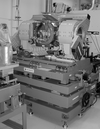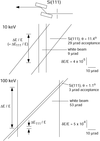issue contents
September 2002 issue

Cover illustration: The reflected amplitude on the ![[sigma]](/logos/entities/sigma_rmgif.gif)
![[pi]](/logos/entities/pi_rmgif.gif) plane of circularly polarized incident radiation in the study of the time dependence of the polarization of short X-ray pulses after crystal reflection, see Graeff, pages 293-297.
plane of circularly polarized incident radiation in the study of the time dependence of the polarization of short X-ray pulses after crystal reflection, see Graeff, pages 293-297.
facility information
research papers
The development and successful operation of a large-area (25 × 20 mm) phase-contrast X-ray imaging system using a two-crystal X-ray interferometer is reported.
A versatile bendable monochromator double-crystal diffractometer was constructed, to investigate, using synchrotron radiation, single-crystal samples with high strain sensitivity and without any reduced image sizes. It is based on a local adaptation of Bragg angles between monochromator and sample.
The natural bandwidth of a single-line undulator is used to measure solution scattering and optimize flux requirements for laser-pump–X-ray-probe time-resolved excitation studies.
The time dependence of the polarization of short X-ray pulses is simulated by Fourier transforms using the steady-state solutions from dynamical theory. The mixed states in particular show a very pronounced time dependence, as perpendicular and parallel polarization components have a different time response.
Atomic applications for XFELs are presented that include strong field effects, multiple ionization and hollow-atom formation.
First time-resolved X-ray absorption spectroscopy experiments to study oxidation state and structural changes of biological metal centers are reported. The future impact of time-resolved BioXAS is discussed.
An X-ray diffractometer has been designed for industrial applications and installed at SPring-8 BL24XU in Japan. The diffractometer has been used for the grazing-incidence X-ray diffraction measurement of ion-implanted chromium-coated samples and for the X-ray stress measurement of polished stainless steel using our proposed new method.
X-ray focusing with an elliptically figured mirror is investigated.
A cryogenically cooled silicon monochromator for high-energy undulator X-rays (50–200 keV) using two bent Laue crystals is presented.
short communications
A description of the commissioning of a new high-pressure flow cell, used to monitor in situ precipitation of barium sulphate under non-ambient conditions.


 journal menu
journal menu


































